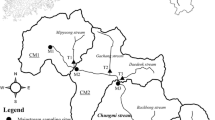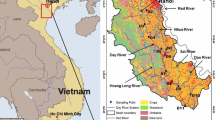Abstract
One of the highest concentrations of swine and poultry concentrated animal feeding operations (CAFOs) in North America is located on the Coastal Plain of North Carolina, in which the Cape Fear River basin is located. The CAFOs produce vast amounts of manure causing loading of nutrients and other pollutants to receiving waters. With the Cape Fear River basin vulnerable to nutrient pollution, as are many other watersheds with CAFOs, δ13C and δ15N stable isotopic signatures were identified from water samples collected within the Northeast Cape Fear, Black, and lower Cape Fear River watersheds to trace nutrient sources and their distribution downstream. The spatial and temporal variability of nutrients and isotopic signatures were also identified to understand water quality impacts of animal waste spraying season and proximity to CAFOs. Our results showed that significantly enriched δ15N signatures characterized sites in close proximity to CAFOs as well as point-source wastewater discharge areas, while the opposite was true for an unimpacted control stream and two estuarine sites. Additionally, the impacted sites yielded significantly (p < 0.05) higher nitrate concentrations than control and estuarine sites. Statistical analyses demonstrated that nitrate concentrations were positively correlated with heavier δ15N signatures, suggesting that animal waste, as well as human wastewater, are relatively more important sources of N to this large watershed than fertilizers from traditional row crop agriculture. Our results also suggested that during appropriate hydrological conditions CAFO-derived N can be detected many kilometers downstream from freshwater sources areas to the estuary.







Similar content being viewed by others

References
Amini, A., Aponte-Morales, V., Wang, M., Dilbeck, M., Lahav, O., Zhang, Q., et al. (2017). Cost-effective treatment of swine wastes through recovery of energy and nutrients. Waste Management, 69, 508–517. https://doi.org/10.1016/j.wasman.2017.08.041.
Bateman, A. S., & Kelly, S. D. (2007). Fertilizer nitrogen isotope signatures. Isotopes in Environmental and Health Studies, 43, 237–247.
Burkholder, J. M., Libra, B., Weyer, P., Heathcote, S., Kolpin, D., Thorne, P. S., & Wichman, M. (2007). Impacts of waste from concentrated animal feeding operations on water quality. Environmental Health Perspectives, 115, 308–312. https://doi.org/10.1289/ehp.8839.
Cahoon, L., Mikucki, J., & Mallin, M. A. (1999). Nitrogen and phosphorus imports to the Cape Fear and Neuse River basins to support intensive livestock production. Environmental Science and Technology, 33, 410–415. https://doi.org/10.1021/es9805371.
Cambardella, C. A., & Elliott, E. T. (1992). Particulate soil organic-matter changes across a grassland cultivation sequence. Soil Science Society of America Journal, 56, 777–783. https://doi.org/10.2136/sssaj1992.03615995005600030017x.
Choi, E. (2007). Piggery waste management. London: IWA Publishing.
Conrad-Acuña, T., Fisher, T., Gonzalez, P., Hatcher, A., Shooter, M., & Spearman, B. (2019). Bermudagrass production in North Carolina [PDF] (pp. 8-9). Raleigh: North Carolina Cooperative Extension Service Retrieved from https://duplin.ces.ncsu.edu/wp-content/uploads/2014/05/AgBermudagrassAG-493.pdf?fwd=no.
Costanzo, S. D., O’Donohue, M. J., Dennison, W. C., Loneragan, N. R., & Thomas, M. (2001). A new approach for detecting and mapping sewage impacts. Marine Pollution Bulletin, 42, 149–156.
Day, R. W., & Quinn, G. P. (1989). Comparisons of treatments after an analysis of variance in ecology. Ecological Monographs, 59, 433–463. https://doi.org/10.2307/1943075.
Environmental Working Group (EWG) and Waterkeeper Alliance. 2016. Fields of filth. Licensed data used with permission of EWG and Waterkeeper Alliance. Map accessible online at ewg.org and Waterkeeper.org.
Fernandes, A. M., Hissler, C., da Conceição, F. T., Spatti Jr., E. P., & Mortatti, J. (2016). Combined analysis of trace elements and isotopic composition of particulate organic matter in suspended sediment to assess their origin and flux in a tropical disturbed watershed. Environmental Pollution, 218, 844–854.
Fry, B. (2006). Stable isotope ecology. New York, NY: Springer Science+Business Media, LLC.
Haines, J., and L. Staley (Eds.). 2004. Risk management evaluation for concentrated animal feeding operations (EPA/600R-04/042). Cincinnati, OH: U.S. Environmental Protection Agency, National Risk Management Research Laboratory. Retrieved from https://nepis.epa.gov
Harden, S.L. 2015. Surface-water quality in agricultural watersheds of the North Carolina Coastal Plain associated with concentrated animal feeding operations: U.S. Geological Survey Scientific Investigations Report 2015–5080, 55, doi:https://doi.org/10.3133/sir20155080
Heaton, T. H. E. (1986). Isotopic studies of nitrogen pollution in the hydrosphere and atmosphere: a review. Chemical Geology, 59, 87–102.
Hribar, C. (2010). Understanding concentrated animal feeding operations and their impact on communities. National Association of local boards of health. Ohio: Bowling Green.
Huddleston, J.H. 1996. How soil properties affect groundwater vulnerability to pesticides contamination. Oregon state extension service. Available: http://wwwagcomm.ads.orst.edu/AgComWebFile/EdMat/EM8559.pdf
Karr, J. D., Showers, W. J., Gilliam, J. W., & Andres, A. S. (2001). Tracing nitrate transport and environmental impact from intensive swine farming using delta nitrogen-15. Journal of Environmental Quality, 30, 1163–1175.
Kellogg, R. (2000). Potential priority watersheds for protection of water quality from contamination by manure nutrients. Proc. Wat. Environ. Fed., 2000, 646–665. https://doi.org/10.2175/193864700784995064.
Kendall, C., & McDonnell, J. (1998). Isotope tracers in catchment hydrology (p. 531). Amsterdam: Elsevier.
Koroleff, F. (1983). Determination of total nitrogen and phosphorus. In K. Grasshof, M. Erhardt, & K. Kremiing (Eds.), Methods for seawater analysis (2nd ed., pp. 162–173). Weinhelm: Verlag Chemie.
Lapointe, B. E., Herren, L., & Paule, A. (2017). Septic systems contribute to nutrient pollution and harmful algal blooms in the St. Lucie Estuary, Southeast Florida, USA. Harmful Algae, 70, 1–22. https://doi.org/10.1016/j.hal.2017.09.005.
Macko, S. A., & Ostrom, N. E. (1994). Pollution studies using stable isotopes. In K. Lajtha & R. H. Michener (Eds.), Stable. Isot. Eco. Envir. Sci (pp. 42–65). London: Blackwell Scientific.
Mallin, M. A., & Cahoon, L. B. (2003). Industrialized animal production - a major source of nutrient and microbial pollution to aquatic ecosystems. Population and Environment, 24, 369–385. https://doi.org/10.1023/a:1023690824045.
Mallin, M. A., & McIver, M. R. (2018). Season matters when sampling streams for swine CAFO waste pollution impacts. Journal of Water and Health, 16, 78–86. https://doi.org/10.2166/wh.2017.194.
Mallin, M. A., McIver, M. R., Ensign, S. H., & Cahoon, L. B. (2004). Photosynthetic and heterotrophic impacts of nutrient loading to blackwater streams. Ecological Applications, 14, 823–838. https://doi.org/10.1890/02-5217.
Mallin, M. A., Johnson, V. L., Ensign, S. H., & MacPherson, T. A. (2006). Factors contributing to hypoxia in rivers, lakes, and streams. Limnology and Oceanography, 51, 690–701. https://doi.org/10.4319/L-1o.2006.51.1_part_2.0690.
Mallin, M. A., McIver, M. R., Robuck, A., & Dickens, A. (2015). Industrial swine and poultry production causes chronic nutrient and fecal microbial stream pollution. Water, Air, and Soil Pollution, 226. https://doi.org/10.1007/s11270-015-2669-y.
Martin, K., Emanuel, R., & Vose, J. (2018). Terra incognita: the unknown risks to environmental quality posed by the spatial distribution and abundance of concentrated animal feeding operations. The Science of the Total Environment, 642, 887–893. https://doi.org/10.1016/j.scitotenv.2018.06.072.
McBride, W. D., & Key, N. (2013). U.S. hog production from 1992 to 2009: Technology, restructuring, and productivity growth (ERR-158). U.S. Department of Agriculture, Economic Research Service. Retrieved from https://www.ers.usda.gov/webdocs/publications/45148/40364_err158.pdf
National Climatic Data Center (NCDC). 2018. Climate of North Carolina [PDF file]. Retrieved from https://www.ncdc.noaa.gov/climatenormals/clim60/states/Clim_NC_01.pdf
Nebbioso, A., & Piccolo, A. (2013). Molecular characterization of dissolved organic matter (DOM): a critical review. Analytical and Bioanalytical Chemistry, 405, 109. https://doi.org/10.1007/s00216-012-6363-2.
North Carolina Department of Environmental Quality (NCDEQ). 2016. List of permitted animal facilities. Available online at https://deq.nc.gov/cafo-map.
North, J., Frew, R., & Peake, B. (2004). The use of carbon and nitrogen isotope ratios to identify landfill leachate contamination: Green Island Landfill, Dunedin, New Zealand. Environment International, 30, 631–637. https://doi.org/10.1016/j.envint.2003.12.006.
Robinson, P.J. 2005. Weather & climate (Stuart, A.W. Ed.). Revised from the North Carolina atlas revisited. Retrieved from https://www.ncpedia.org/climate
Rosov, K. A., Mallin, M. A., & Cahoon, L. B. (2020). Waste nutrients from U.S. animal feeding operations: Regulations are inconsistent across states and inadequately assess nutrient export risk. Journal of Environmental Management, 269, 110738. https://doi.org/10.1016/j.lenvman.2020.110738.
Schlotzhauer, S. D. (2009). Elementary statistics using SAS. Cary: SAS Institute, Inc..
Smock, L.A. and E. Gilinsky. 1992. Coastal plain blackwater streams. In: Biodiversity of the Southeastern United States (C. T. Hackney, S. M. Adams & W. H. Martin, eds). John and Wiley and Sons, Inc. New York, NY.
Thornton, S. F., & McManus, J. (1994). Application of organic carbon and nitrogen stable isotope and C/N ratios as source indicators of organic matter provenance in estuarine systems: Evidence from the Tay Estuary, Scotland. Estuarine, Coastal and Shelf Science, 38, 219–233. https://doi.org/10.1006/ecss.1994.1015.
U.S. Environmental Protection Agency (USEPA). 2002. Wastewater technology fact sheet: anaerobic lagoons (EPA 382-F-02-009). Retrieved from https://nepis.epa.gov/
U.S. Environmental Protection Agency (USEPA). 2004. National Risk Management Research Laboratory. Risk Management Evaluation for Concentrated Animal Feeding Operations. EPA/600R-04/042.
U.S. Environmental Protection Agency (USEPA). 2017. NPDES compliance inspection manual (305-K-17-001, Rev. ed.). Retrieved from https://nepis.epa.gov
U.S. Geological Survey (USGS) Groundwater Watch. 2019. Retrieved from https://groundwaterwatch.usgs.gov/AWLSites.asp?mt=g&S=335631078003606&ncd=awl
Wassenaar, L. I. (1995). Evaluation of the origin and fate of nitrate in the Abbottsford aquifer using the isotopes of 15N and 18O in NO3−. Applied Geochemistry, 10, 391–405.
Wing, S., Freedman, S., & Band, L. (2002). The potential impact of flooding on confined animal feeding operations in eastern North Carolina. Environmental Health Perspectives, 110, 387–391.
Acknowledgements
We thank Matthew McIver, Nick Iraola, Amy Grogan, Kim Breen and Adam Lucas for their assistance in collecting and processing samples. Additionally, we thank Kim Duernberger and UNCWiRMS for the generous help in running the isotope analyses. We thank Kerry Mapes for providing CAFO data for POULT and the Environmental Working Group (ewg.org) and Waterkeeper Alliance (waterkeeper.org) for permissions to use this licensed data pertaining to locations of North Carolina poultry operations. We further thank Drs. L.B. Cahoon and S.A. Skrabal for valuable study input.
Funding
Funding for this project was provided by UNCW Department of Earth and Ocean Sciences, Center for the Support of Undergraduate Research and Fellowships (CSURF), and the Lower Cape Fear River Program.
Author information
Authors and Affiliations
Corresponding author
Additional information
Publisher’s note
Springer Nature remains neutral with regard to jurisdictional claims in published maps and institutional affiliations.
Rights and permissions
About this article
Cite this article
Brown, C.N., Mallin, M.A. & Loh, A.N. Tracing nutrient pollution from industrialized animal production in a large coastal watershed. Environ Monit Assess 192, 515 (2020). https://doi.org/10.1007/s10661-020-08433-9
Received:
Accepted:
Published:
DOI: https://doi.org/10.1007/s10661-020-08433-9



